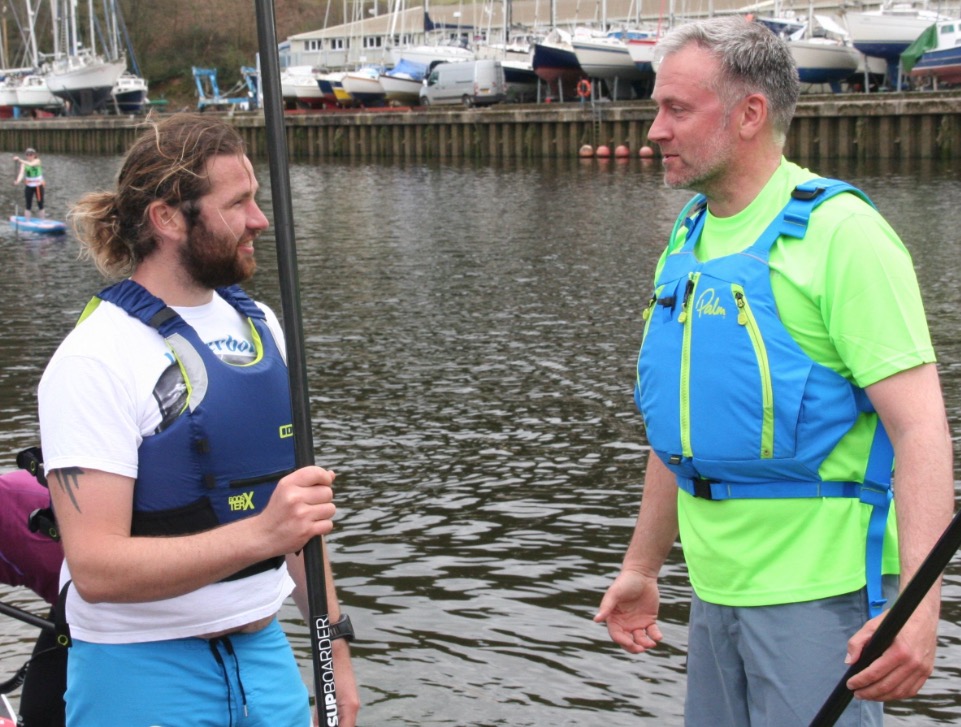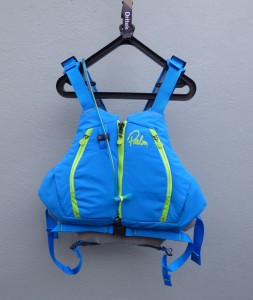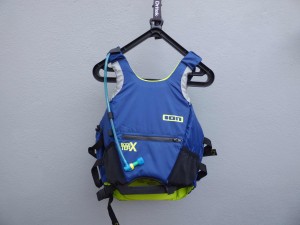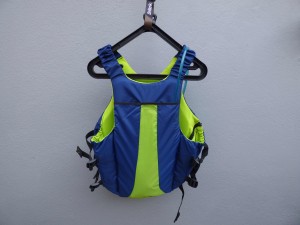
Personal Floatation Devices or PFDs have a bit of an image problem in SUP with many people assuming that they are not for SUPers unless you are learning. However times are changing and more manufacturers are aiming their PFDs at SUP, changing our perceptions and making PFDs a useful piece of kit out on the water as well as in! SUPboarder have two PFDs for review, the Palm Peyto and the ION Booster X;
Palm Peyto – £99.99
The Peyto is described by Palm as ‘…a premium, all season PFD.’ The Peyto tested is pale blue with vivid green zips and highlights with some reflective detailing. The rear panel has a pocket for a drinks bladder and the front panel has two zipped pockets, two hidden hand warmer pockets and a clip to secure a hose from a bladder if used. In each pocket is a plastic D ring, perfect for securing a waterproof key pouch or similar.
Ion Booster X – £59.99
The Booster X is the only buoyancy aid in Ion’s 2016 range. The one we have on test is dark blue with green highlights and reflective trim. Like the Peyto it has a pocket on the back panel to accommodate a drinks bladder, on the front is a single central zip pocket, two small mesh pockets and two Velcro loops for securing a hose.
Both devices are buoyancy aids, not life jackets. They are intended for paddlers in sheltered waters where a bulky device would impede movement possibly creating a more dangerous situation. Both PFDs are certified to ISO 12402-5 which is for 50N general usage devices. But Palm go further and also have certification for ISO 12402-6 for 50N special purpose devices. And, according to the Palm website they go further than the ISO certification and have around 20% more buoyancy than required to meet the standards. The Peyto certainly feels to have more material in it than the Ion.
In the water both kept the 100 kg tester afloat quite happily in calm conditions.
In Use
The first PFD tested was the Peyto. This is worn like a jacket with a large zip at the front, and a central fastening waist strap. Once on it’s easy to adjust to get a perfect fit. The adjustable shoulder straps, waist strap and side straps all being easy to tighten, and ease off, when the PFD is being worn. There is enough length in the shoulder straps to make sure the the waist strap, or 3D anti-ride up waist belt, sits correctly ensuring that the PFD stays put when it’s needed, and is not going to bob up to your chin when you hit the water. To help with that the inside face of the waist belt has an anti-slip coating. Palm have spent some time making sure that all the lose ends of the shoulder straps can be tided away, presumably from their kayaking roots, and the result is a very neat appearance in use.
Next up was the Booster X. This is worn more like a jumper with a short zip on the right hand side, and the waist belt fastens on the same side. The shoulder straps are elasticated with no adjustment and there are two straps on each side to adjust the fit. Using these means that it is easy to get a good fit but it is not as snug as the more expensive Peyto. Importantly the position of the waist strap in relation to the length of the wearers torso is not adjustable, and therefore if the strap is not tight then the PFD is likely to rise up.
Both PFDs have a few places to stash gear and liquid. Both are capable of holding a 2l (but no larger) water bladder, stored in a pouch on the back panel. On the Peyto this is a zipped compartment which has a ‘d’ ring inside to attach the bladder to. Undoubtably the D ring is a very strong anchor point but not all hydration packs can clip to it, many expect a clip in the pack. The Booster X has a pouch for a hydration pack that is secured with a velcro tab, inside is a plastic clip to hold the bladder in place. Both have an elastic loop on the right shoulder to hold the hose in place, the Peyto uses a plastic clip on the right chest panel to hold the hose firmly in place, the Booster X has two short velcro straps. Again both work but the Palm solution is neater.
Palm have put two zipped pockets on the front of their PFD, and each has a D loop inside to secure keys, a radio or valuables, Both pockets have drain holes as does the rear pocket. Behind each zipped pocket is a hand warmer pocket lined with a micro-fleece type material that does a good job on cold days of bringing a little life back into cold hands. Ion have put one central zipped pocket for valuables, again with a key clip, but sadly this pocket does not have any drainage and will hold some water. To the side of this are two mesh pouches, ideal for smaller items that may be needed mid-paddle.
So where does the extra £40 go?
Both PFDs work and do as they are supposed to, both are comfortable to wear on long paddles and the ability to carry 2l of liquid is enough of a reason to wear one. The Palm appears to be finished to a higher standard, for example the drainage holes on each pocket and on the pouch are sewn like a button hole on a shirt and the straps along wth higher quality straps and the buckles and extra design features are where the extra pounds are spent. But the cheaper Booster X has some features that may suit, using a clip to hold the bladder in place is standard on most multi sport rucksacks, and the central pocket will hold a little more than the two pockets on the Palm, the pouch on the back panel is fractionally longer than the pocket on the Palm (but still not large enough for a 3l bladder). The 2l limit is likely because these PFDs are designed to be used in a Kayak as well as SUP, and a longer back would likely to impede on other watersports.
Neither have a whistle, a feature that’s increasingly common on other packs that often incorporate this important safety feature in a buckle.
Palm
Pros ISO Certified, good looking, comfortable PFD with features that any paddler would use. Comfortable against the skin.
Cons None
Ion
Pros ISO Certified, functional PFD with similar features to the Palm
Cons Elasticated shoulders limit adjustability.
SUPboarder verdit
Both are excellent bits of kit that do exactly what they are supposed to. As buoyancy aids both will help an adult stay afloat and both are comfortable to wear when paddling with space to carry fluid and equipment. Of the two the nod has to go to the Palm, the extra details, higher quality finish and extra buoyancy justify the extra cost. But the cheaper Ion runs in close for value for money, for the same level of ISO certification.
Website product pages
Palm : palmequipmenteurope.com
Ion : www.ion-products.com






Where are you buying the Peyto for £99? They seem to be £125 on Palm and most other sites.
Hi Libby
Sorry this is an-order post so the price may have changed. I have done a quick search and found them in the UK for £109. So yes it looks like they have gone up in price a bit.